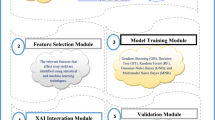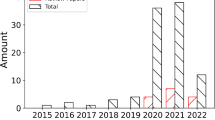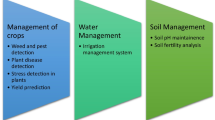Abstract
The agriculture industry is currently dealing with serious issues with rice plants as a result of illnesses that decrease the quantity and output of the harvest. Numerous fungi and bacteria diseases harm plants that affect the growth of yield. So identification of the detection of crop diseases is essential for enhancing the productivity of crops. Many techniques have been developed to improve disease detection in crops but there are still some issues such as noise, time consumption, delay, poor segmentation, and less accuracy. To overcome these issues, this paper, designed a Spider Monkey-based Random Forest (SMbRF) model for accurate detection and classification of rice leaf diseases and the designed model was implemented in the Python system. The main aim is to develop an optimization-based random forest technique for accurate prediction of rice leaf disease by exact segmentation. Initially, preprocessing is performed to enhance the data quality and remove errors. Furthermore, separate the lesions using mean shift image segmentation and extract the shape and color features to improve the detection results of the developed model. As well, spider monkey fitness is updated in the RF classification layer for accurate classification of diseases and improves accuracy with less execution time. The experiment results show the reliability and efficiency of the designed model, it attains better performance in accuracy, sensitivity, specificity, and precision. The designed model attained 99.29% accuracy, 99.52% sensitivity, 98.76% precision, and 99% specificity proving the scalability of the designed model.













Similar content being viewed by others
Data availability
Data sharing is not applicable to this article as no new data were created or analyzed in this study.
Code availability
Not applicable.
References
Gu H-Y, Wang C-W (2020) Impacts of the COVID-19 pandemic on vegetable production and countermeasures from an agricultural insurance perspective. J Integr Agric 19(12):2866–2876
Besser H et al (2021) Ecologic and economic perspectives for sustainable irrigated agriculture under arid climate conditions: An analysis based on environmental indicators for southern Tunisia. J Afr Earth Sci 177:104134
Zhai Z et al (2020) Decision support systems for agriculture 4.0: Survey and challenges. Comput Electron Agric 170:105256
Patrício DI, Rieder R (2018) Computer vision and artificial intelligence in precision agriculture for grain crops: A systematic review. Comput Electron Agric 153:69–81
Krishnan RS et al (2020) Fuzzy logic based smart irrigation system using internet of things. J Clean Prod 252:119902
Sujatha R et al (2021) Performance of deep learning vs machine learning in plant leaf disease detection. Microprocess Microsyst 80:103615
Lakitan B et al (2018) Recognizing farmers’ practices and constraints for intensifying rice production at Riparian Wetlands in Indonesia. NJAS-Wageningen J Life Sci 85:10–20
Chandio AA, Gokmenoglu KK, Ahmad F (2021) Addressing the long-and short-run effects of climate change on major food crops production in Turkey. Environ Sci Pollut Res 28(37):51657–51673
Khan MA, Ahmad S, Raza A (2019) Integrated weed management for agronomic crops. Agronomic crops, vol 2. Springer, Singapore, pp 257–281
Sathe AP et al (2021) Role of silicon in elevating resistance against sheath blight and blast diseases in rice (Oryza sativa L.). Plant Physiol Biochem 166:128–139
Nigam A, Tiwari AK, Pandey A (2020) Paddy leaf diseases recognition and classification using PCA and BFO-DNN algorithm by image processing. Mater Today: Proc 33:4856–4862
Fahad S, Adnan M, Noor M, Arif M, Alam M, Khan IA, Ulla H, Wahid F, Mian IA, Jamal Y, Basir A, Hassan S, Saud S, Amanullah, Riaz M, Wu C, Khan MA, Wang D (2019) Major constraints for global rice production. In Advances in Rice Research for Abiotic Stress Tolerance. Woodhead Publishing, pp 1–22
Ünal Z (2020) Smart farming becomes even smarter with deep learning—a bibliographical analysis. IEEE Access 8:105587–105609
Kumar P et al (2018) Inoculation of siderophore producing rhizobacteria and their consortium for growth enhancement of wheat plant. Biocatalysis Agric Biotechnol 15:264–269
Devi J, Sagar V, Kaswan V, Ranjan JK, Kumar R, Mishra GP, Dubey RK, Verma RK (2021) Advances in breeding strategies of bell pepper (Capsicum annuum l. var. grossum sendt.). Advances in plant breeding strategies: Vegetable crops. Volume 9: Fruits and Young Shoots. Springer, Cham, pp 3–58
Singh A et al (2021) Challenges and opportunities in machine-augmented plant stress phenotyping. Trends Plant Sci 26(1):53–69
Nweke HF et al (2019) Data fusion and multiple classifier systems for human activity detection and health monitoring: Review and open research directions. Inf Fusion 46:147–170
Anubhove ST, Masum Ahmed SM, Zeyad M, Walid AA, Ashrafi N, Saleque AM (2022) Tomato’s disease identification using machine learning techniques with the potential of AR and VR technologies for inclusiveness. In Advances in Augmented Reality and Virtual Reality. Springer, Singapore, pp 93–112
Wani JA, Sharma S, Muzami M, Ahmed S, Sharma S, Singh S (2021) Machine learning and deep learning based computational techniques in automatic agricultural diseases detection: Methodologies, applications, and challenges. Arch Comput Meth Eng 9(1):1–37
Selvaraj MG et al (2020) Detection of banana plants and their major diseases through aerial images and machine learning methods: A case study in DR Congo and Republic of Benin. ISPRS J Photogramm Remote Sens 169:110–124
Ale L, Sheta A, Li L, Wang Y, Zhang N (2019) Deep learning based plant disease detection for smart agriculture. In proceedings of 2019 IEEE Globecom Workshops (GC Wkshps). IEEE, pp 1–6
Syed-Ab-Rahman SF, Hesamian MH, Prasad M (2022) Citrus disease detection and classification using end-to-end anchor-based deep learning model. Appl Intell 52(1):927–938
Atitallah SB et al (2020) Leveraging Deep Learning and IoT big data analytics to support the smart cities development: Review and future directions. Comput Sci Rev 38:100303
Ashok V, Vinod DS (2021) A novel fusion of deep learning and android application for real-time mango fruits disease detection. In proceedings of Intelligent System Design. INDIA 2019. Springer, Singapore, pp 781–791
Karpyshev P, Ilin V, Kalinov I, Petrovsky A, Tsetserukou D (2021) Autonomous mobile robot for apple plant disease detection based on cnn and multi-spectral vision system. In proceedings of 2021 IEEE/SICE International Symposium on System Integration (SII). IEEE, pp 157–162
Suryono H, Kuswanto H, Iriawan N (2022) Rice phenology classification based on random forest algorithm for data imbalance using Google Earth engine. Procedia Comput Sci 197:668–676
Choudhary K, Shi W, Dong Y, Paringer R (2022) Random forest for rice yield mapping and prediction using sentinel-2 data with google earth engine. Adv Space Res 70(8):2443–2457
Feng S et al (2022) A deep convolutional neural network-based wavelength selection method for spectral characteristics of rice blast disease. Comput Electron Agric 199:107199
Patil RR, Kumar S (2022) Rice-fusion: A multimodality data fusion framework for rice disease diagnosis. IEEE Access 10:5207–5222
Krishnamoorthy N et al (2021) Rice leaf diseases prediction using deep neural networks with transfer learning. Environ Res 198:111275
Jiang F et al (2020) Image recognition of four rice leaf diseases based on deep learning and support vector machine. Comput Electron Agric 179:105824
Chen J et al (2020) Detection of rice plant diseases based on deep transfer learning. J Sci Food Agric 100(7):3246–3256
Shrivastava VK, Pradhan MK (2021) Rice plant disease classification using color features: a machine learning paradigm. J Plant Pathol 103(1):17–26
Ahmed U, Lin J-W, Srivastava G (2022) Mitigating adversarial evasion attacks of ransomware using ensemble learning. Comput Electr Eng 100:107903
Lafta R, Zhang J, Tao X, Li Y, Diykh M, Lin JC-W (2018) A structural graph-coupled advanced machine learning ensemble model for disease risk prediction in a telehealthcare environment. Big data in Engineering Applications, Studies in Big Data 44:363–384
Chen C-H, Chen P-Y, Lin JC-W (2022) An ensemble classifier for stock trend prediction using sentence-level Chinese news sentiment and technical indicators. Special Issue on Artificial Intelligence in Economics, Finance and Business
Yadav A et al (2022) AFD-Net: Apple Foliar Disease multi classification using deep learning on plant pathology dataset. Plant Soil 477(1–2):595–611
Chen H-C et al (2022) AlexNet convolutional neural network for disease detection and classification of tomato leaf. Electronics 11(6):951
Ahmed U et al (2021) A nutrient recommendation system for soil fertilization based on evolutionary computation. Comput Electron Agric 189:106407
Zheng L, Zhang J, Wang Q (2009) Mean-shift-based color segmentation of images containing green vegetation. Comput Electron Agric 65(1):93–98
Author information
Authors and Affiliations
Corresponding author
Ethics declarations
Human and animal rights
This article does not contain any studies with human or animal subjects performed by any of the authors.
Informed consent
Informed consent does not apply as this was a retrospective review with no identifying patient information.
Consent to participate
Not applicable.
Consent for publication
Not applicable.
Conflict of interest
The authors declare that they have no conflict of interest.
Additional information
Publisher's Note
Springer Nature remains neutral with regard to jurisdictional claims in published maps and institutional affiliations.
Rights and permissions
Springer Nature or its licensor (e.g. a society or other partner) holds exclusive rights to this article under a publishing agreement with the author(s) or other rightsholder(s); author self-archiving of the accepted manuscript version of this article is solely governed by the terms of such publishing agreement and applicable law.
About this article
Cite this article
Rajasekhar, V., Arulselvi, G. & Babu, K.S. Design an optimization based ensemble machine learning framework for detecting rice leaf diseases. Multimed Tools Appl (2024). https://doi.org/10.1007/s11042-024-19134-7
Received:
Revised:
Accepted:
Published:
DOI: https://doi.org/10.1007/s11042-024-19134-7




